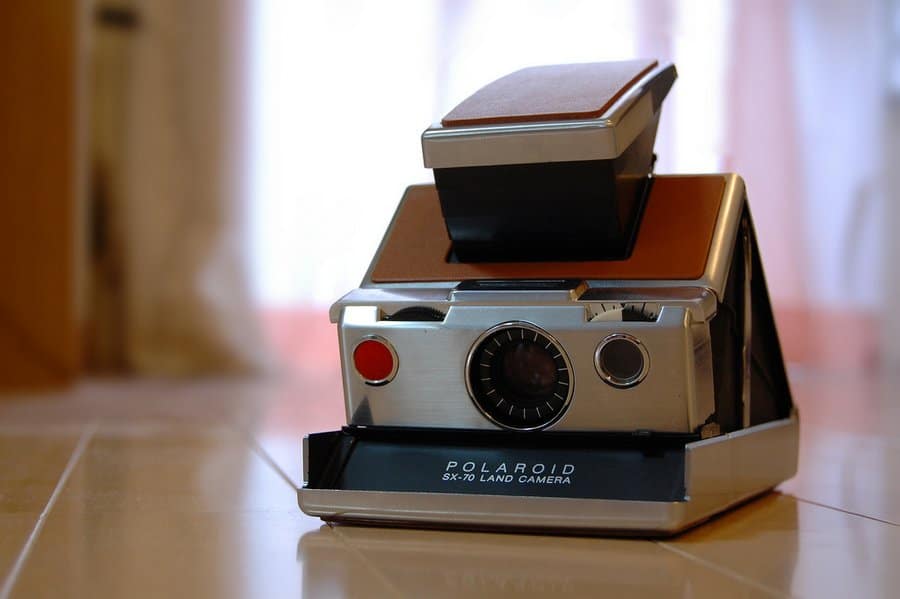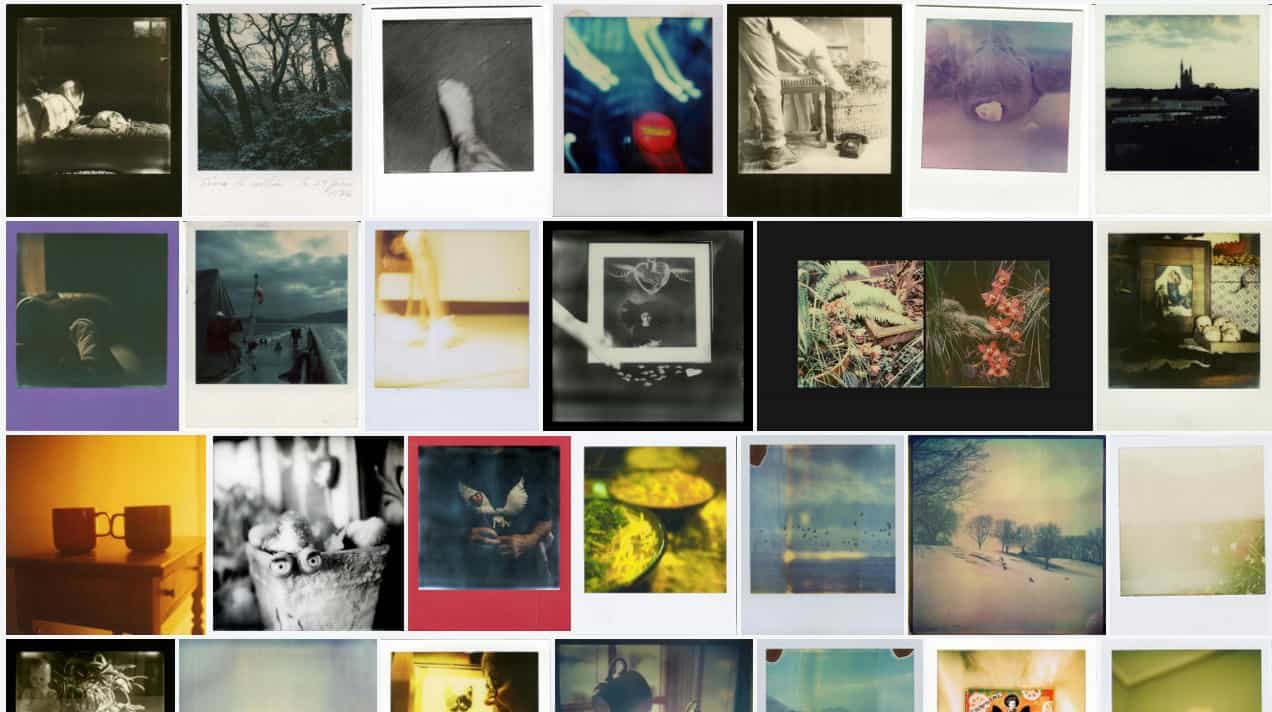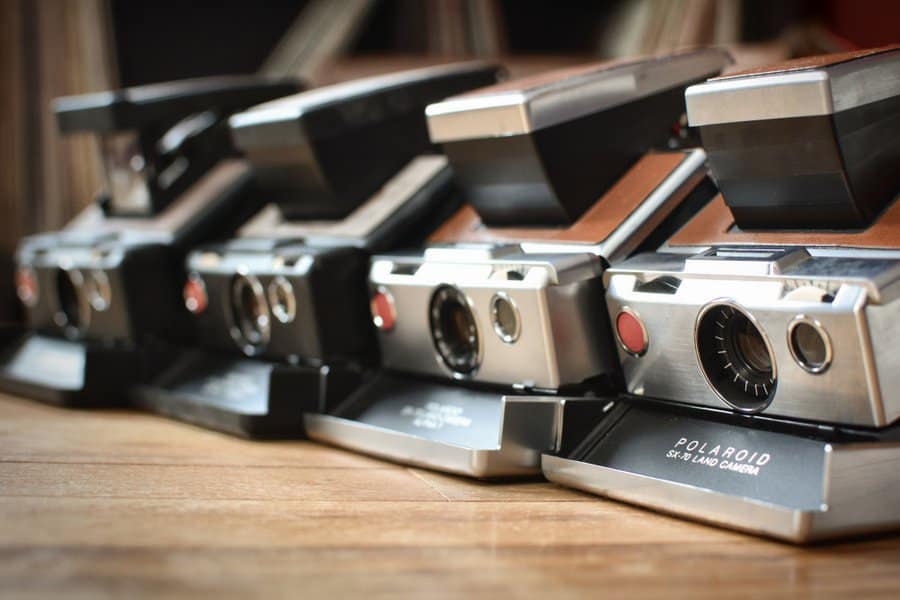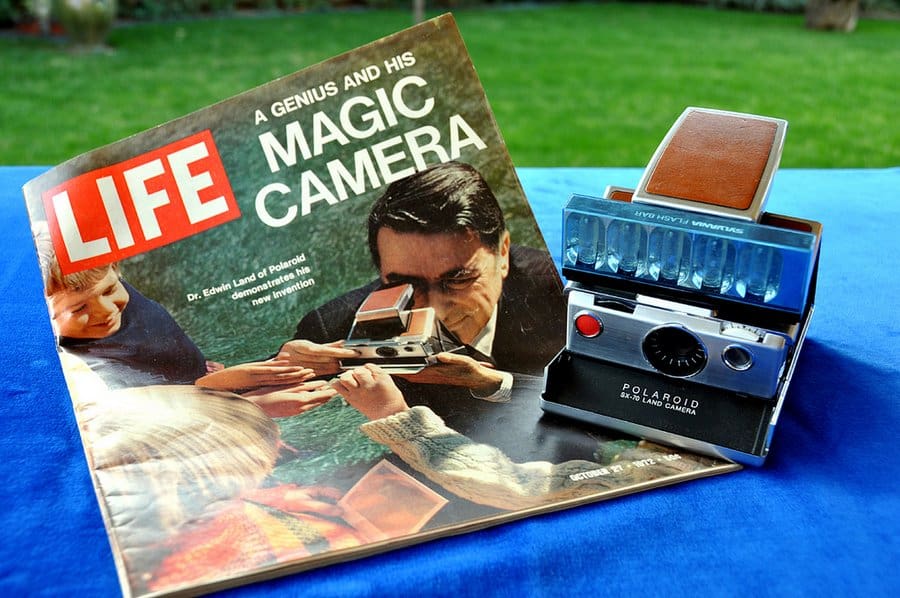If you’re a newcomer to Polaroid cameras and the wonderful Polaroid SX-70, you might not know where to start and which model to choose. Since its launch in the 1950s, the Polaroid Company has been a prolific producer of camera models, sometimes even two per decade, reaching a varied audience of photography enthusiasts. As a matter of facts, Polaroid almost built its instant photography empire on four emblematic models: the Polaroid SX-70, the Polaroid 200 series, the Polaroid 600 series and the Polaroid 1000.
Launched in 1972, the Polaroid SX-70 will be an easy choice for those who, above anything else, love elegant lines, refined surfaces and nonetheless the thrill and charm of unfolding a camera before taking a photo. A favourite of photographers and artists such as Anselm Adams, Andy Warhol, Lucas Samaras and others, the Polaroid SX-70 is a classic, compact camera with the benefits of a single-lens reflex camera (SLR).
The charm of Polaroid SX-70 lies mainly in its foldable body, a feature appreciated by travelers or city explorers who would like to carry an instant camera with them at any time without it taking too much space. As with other Polaroid models, this camera is just as much about seeing and taking photographs as it is about being seen.

Polaroid SX-70 Land Camera © Fabian Reus
Unfolding the Polaroid SX-70 and using it, is but a discrete and invisible act. Polaroid creates objects which are meant to stand out and be noticed, rather than ‘spy’ with. It is bold and conspicuous, both when it comes in bright colours and when covered in a smooth alloy layer. From this point of view, it’s a constant reminder that taking photos is just as much about the process as it is about the resulting object.
Technical Features
The SX-70 is a single lens reflex (SLR) and so it has a manual focus giving the user more freedom for decision, as a semi-automatic camera. The robust plastic body is covered with a layer of copper-nickel alloy to give it a sleek appearance. The glass lens with an f/8 aperture offers a good depth of field, with many background elements in sharp focus.
The original Polaroid SX-70 shares the same kind of focusing system with regular 35 mm analogue cameras: there is a split circle which you can see through the viewfinder. When the image in the upper semicircle and the one in the lower semicircle coincide, the subject is in focus. However, if this might sound too complicated, it’s good to know that an autofocus model of the Polaroid SX-70 was also released soon after the manual focus one. If you purchase this camera model think about which type of focus system is more convenient for your aims and ideas.
The back side presents a useful frame counter, showing the numbers of photographs left from the film cartridge and signaling 0 when the camera is empty. The Polaroid SX-70 comes with an interesting array of accessories, from the useful remote shutter release to the close up lens or the flash-bar mainly used for indoor scenes. The flash bar is detachable and disposable: it comes with two sides, each with 5 bulbs, usable for a number of 10 times.
The Polaroid SX-70 comes in three different models, the Original, Alpha and Sonar, with very few different technical features from each other. Some photographers prefer the Alpha model because it offers the possibility to choose the aperture and the focus. The Polaroid SX-70 can be loaded with the PX 70 Color Shade and PX 100 Silver Shade film types from the Impossible Project or private sellers via ebay or etsy, but make sure they are not expired.

Some users think that despite its beautiful design, the Polaroid SX-70 is a bit inconvenient to shoot with because of having the lens under an angle, pointing down and not straight ahead. Another point on the downside is the fact that when the photos are ejected from the Polaroid SX-70 they are immediately exposed to daylight, which may alter the quality of the photo. Since the first 5 seconds of the developing process are so important, make sure you place the photograph in a dark place immediately after it comes out.
Using the Polaroid SX-70 as Home Décor: How to Use the Instruction Manuals Differently
If you decide to use the Polaroid SX-70 for home décor try it in a room with vintage wooden furniture to match the black or brown leather models, but a contrasting combination, in a room with a more minimalistic design, could also make the Polaroid Sx-70 stand out as an interesting ornament. The original instructions manual for the Polaroid SX-70 contain really interesting images which also make for unique posters, so magnifying one of these in a print shop and combining it with the camera itself can really bring a new mood to any dull wall.

SX-70 Land Camera Collection © Luke Healey
Where to Buy the Polaroid SX-70 and some tips
You can purchase the Polaroid SX-70 online on ebay, etsy, in the shop of refurbished cameras run by the Impossible Project, or also at local flea markets. This Polaroid model tends to be pricey, between 10 and 200 Dollars. So if you find one for a good price, consider buying it even if it’s not fully functional, for its historic value and iconic design. The advantage of buying it online is that you often receive a one-year warranty and accessories for a lower kit price, especially from shops focused on vintage camera trade.
Polaroid SX-70 and Visual Culture
If you’re already one of the lucky owners of a Polaroid SX-70 and appreciate it as a piece of 20th century history, then you may also enjoy watching the documentary ‘Time Zero: The Last Year of Polaroid Film’ directed by Grant Hamilton, to delve more into the history of this object and its founders.
Shot in 2012, 40 years after the launch of the Polaroid SX-70, this documentary pairs well with the 1972 ad for the camera, created by the designers Charles and Ray Eames, another visual treat for enthusiasts. At the time of the camera’s launch, great names of European and American cinema, such as Lawrence Olivier, Liv Ullmann or Christopher Plummer, all starred in ads for the Polaroid SX-70.

SX-70 LAND CAMERA © Coleccionando Camaras
So if you’re curious about how the history of advertising, of cinema and photography blended in the late 70s take a look at the videos, accessible online, on www.openculture.com.
Cover picture Sebastien Wiertz © Polaroid SX-70






